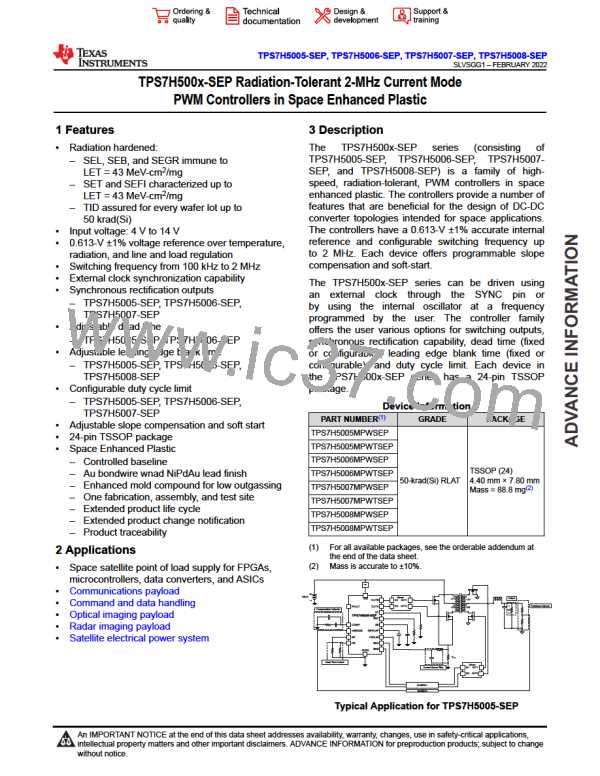TPS7H5005-SEP, TPS7H5006-SEP, TPS7H5007-SEP, TPS7H5008-SEP
www.ti.com
SLVSGG1 – FEBRUARY 2022
8.3.5 Error Amplifier
Each TPS7H500x-SEP controller uses a transconductance error amplifier. The error amplifier compares the
VSENSE pin voltage to the lower of the SS pin voltage or the internal 0.613-V voltage reference. The
transconductance of the error amplifier is 1800 µA/V during normal operation. The frequency compensation
network is connected between COMP pin and AVSS. The error amplifier DC gain is typically 10,000 V/V.
8.3.6 Output Voltage Programming
The output voltage of the power converter is set by using a resistor divider from VOUT of the converter to the
VSENSE pin. The output voltage must be divided down to nominal voltage reference of 0.613 V. Equation 5 can
be used to select RBOTTOM
.
VREF
RBOTTOM
=
× RTOP
VOUT
VREF
(5)
where:
•
•
•
VREF is 0.613 V (typical)
VOUT is the desired output voltage
RTOP is the value of the top resistor, selected by the user (i.e. 10 kΩ)
The recommendation is to use high tolerance resistors (1% or less) for RBOTTOM and RTOP for improved output
voltage setpoint accuracy.
8.3.7 Soft Start (SS)
The soft-start circuit increases the output voltage of the converter gradually until the steady-state programmed
output is reached. During soft start, the error amplifier uses the voltage on the soft-start pin as its reference until
the SS pin voltage rises above VREF. Once the voltage at SS pin is above VREF, the soft-start period is complete.
Note that the voltage at SS pin will continue to rise and once it reaches 1 V, the synchronous rectifier outputs of
the controller will become active.
A capacitor between the SS pin and AVSS controls the soft-start time of the PWM controller. The following
equation can be used to select the capacitor for the desired soft-start time:
tSS × ISS
CSS
=
VREF
(6)
where:
•
•
•
tSS is the desired soft-start time
VREF is voltage reference of 0.613 V (typical)
ISS is the soft-start charging current of 2.7 µA (typical)
8.3.8 Switching Frequency and External Synchronization
Each TPS7H500x-SEP controller has three modes for setting the switching frequency of the device: internal
oscillator, external synchronization, and primary-secondary. The device is placed in one of these modes through
unique configurations of the RT and SYNC pins. Primary-secondary mode can be used when it is desired for two
controllers to have synchronized switching without the use of the external clock.
Copyright © 2022 Texas Instruments Incorporated
Submit Document Feedback
31
Product Folder Links: TPS7H5005-SEP TPS7H5006-SEP TPS7H5007-SEP TPS7H5008-SEP

 TI [ TEXAS INSTRUMENTS ]
TI [ TEXAS INSTRUMENTS ]